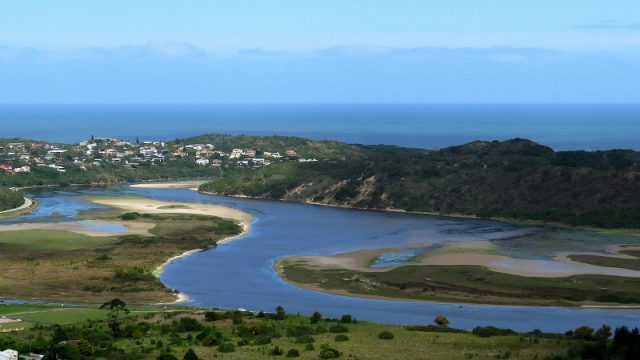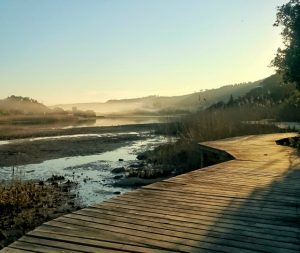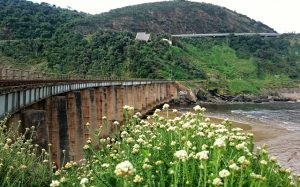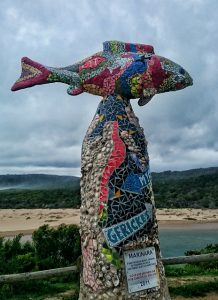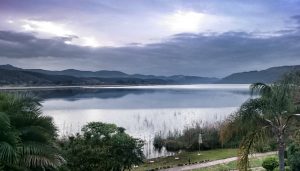The Garden Route is the name given to a stretch of coastline, mountains and forests that extends from Albertina to Storms River, in the Southern Cape region of Western Cape province in South Africa. Best known for the very popular towns of Knysna and Plettenberg Bay, the whole area is ridiculously attractive and positively overflowing with golf courses, nature reserves, game and safari ranches, wildlife sanctuaries, water sports, hiking trails and scenic routes.
I recently spent eight days in a few of the small villages in the area, where life is lived at a slower pace.
Wilderness
Imagine a beach with sand so white it hurts your eyes to look at it. Black rocks, sand dunes covered in green and flowering succulents, fynbos covered mountains rising up from the coastline and roads and a railway line cut into the rock. Houses look on to the dark tannin stained waters of the Touws River, boardwalks beckon and bird calls fill the air. Looking up you will often see para-gliders floating on the thermals above this natural playground, sharing space with Fish Eagles, Reed Cormorants, Kingfishers and Spoonbills. Welcome to the Wilderness. A place for walking shoes, canoes, binoculars and your bathing costume.
Much of the greater Wilderness area is part of the Garden Route National Park which consists of rivers, forests, beaches and lakes. The Wilderness camp offers accommodation and an information office that has useful information on the various hiking trails, MTB Routes, bird hides and other activities within the Park.
Until 2007 a steam train ran between George and Knysna, crossing the iconic Kaaiman’s River Bridge. Extreme flooding after a storm caused a landslide that covered a small section of the tracks high above the Wilderness beach. Since then the steam train no longer operates but part of this railway route can now be enjoyed on foot.
Starting at the old Wilderness station follow the train tracks as they climb into the mountainside, weave through tunnels and afford fantastic views of the beaches. Take time to stop and examine the fynbos and flowers, listen to the birds, breathe in the air and enjoy the contrasts as you wander from sun to shade and into the chill of the tunnels. Scramble down the rough path to the little village of Victoria Bay to watch the surfers and enjoy and ice cream before heading back. A highlight is crossing the old bridge over the Kaaimans River. I was petrified as I am afraid of heights, but it was both heart stopping and worthwhile. The round trip is about 7km.
Just 7 km inland and about 200m above sea level is the rural area of Hoekwil, and the tranquillity of the 7 Passes Tented Camp. Forests and farmlands thrive side by side in these hills. This is the place to truly get away from it all. Hikes, easy walks, bird watching or just lazing on the deck of your tent set on a stilted platform in the trees overlooking the lake.
Sedgefield
In “Sedgies” you will find your sanity. Slow living is celebrated in this official “slow town.” Time is not measured, nature is savoured, and shoes are optional. Slow living encompasses all aspects of life, from finding a healthy balance between work and play, to embracing the community, to conserving the environment and respecting the seasons.
Sedgefield is built around a lagoon and the beach so a water view is almost always an option. Friendliness is the default setting of the locals and you quickly become accustomed to being greeted by everyone.
It is easy to spend all day wandering along the beaches, marveling at the fossilized dunes at Gerrike’s Point, spotting birds while walking along the lagoon towards the sea, or driving around town and stopping at the mosaic installations which are part of a community project. There is plenty to explore for free, but if you like you can add a tour guide which will create a richer experience.
Saturday mornings are for rising early as it is market day. The Mosaic Market, The Wild Oats Farmers Market and the Scarab Village Market all converge just outside of town and it is a festival of shopping for locals, tourists and residents of the surrounding towns. Fresh and home grown local produce is sold out fast, breakfast, brunch, lunch and snacks are consumed at the huge variety of stalls. Crafts, art, wine, beer, clothing and almost anything else you can imagine are sold here.
My personal favourite is the Currywurst from Wurst Express, and I never leave without a few bottles of Jan’s special sauce.
If you are visiting the area, you absolutely must include a Saturday in Sedgefield.
Injured or human imprinted birds of prey find a safe haven at Radical Raptors , an education and rehabilitation centre situated on the N2 approaching Plettenberg Bay.
Flying displays are offered three times a day at 11am, 1pm and 3pm and are educational and entertaining. Dennis is clearly passionate about these birds and a staunch conservationist as well.
He explains that birds raised by humans are unable to be released into the wild as they would not have the instincts or skills needed to survive. These birds need to be exercised and they are used in the educational displays. Dennis knows each bird intimately and he is spot on in his description of their different personalities. The Rock Kestrel loves to show off and swoops and swirls gracefully for the small audience. The Crowned Eagle wants to be in charge, and even when tempted with food will only fly when she feels like it. My favourite, the Spotted Eagle Owl is cheeky and swoops over our heads brushing our hair before circling for another round. Dennis offers us a glove and we extend our arms for an up close look at the various birds as the fly in and perch inches from our faces. . This visit taught me a lot about rat poisons and other pesticides and the huge threat they pose to these glorious birds.
Nature’s Valley
This exquisite area is only slightly tamed, nature is in charge here. From 250m above sea level at the National Road, a narrow pass curls and bends through a tangled forest for 12 km before giving you a sneak preview of a jaw dropping beach unmarred by too many footprints.
This small settlement consists of about 10 narrow streets laid out in a dense forest that leads to the beautiful beach. I stayed at Lily Pond Lodge which is on the road that leads to the village.
Conservationists will love this area as there are numerous sanctuaries within a 20km drive.
I met the dynamic Lara Mostert, one of the passionate wildlife activists behind Birds of Eden, Monkeyland and Jukani Wildlife Sanctuary. Lara took me on a guided tour around Birds of Eden talking with pride and passion about the 3500 birds now living here. The area is 2.17 hectares of trees, waterfalls, a river and dams, creating a very natural feel to a controlled environment. The birds can fly fairly freely as in parts the huge mesh enclosure is 35 metres high.
Monkeyland operates on a similar system, with lemurs, vervets and capuchin just a few of the curious primates you can see as you walk through the tree paths.
Jukani is where you will find the big cats, lion, cheetah, black and snow leopard and caraculs. Each animal has a sad story to tell and although very educational a visit is a very sobering experience.
All the sanctuaries mentioned are opposed to any human interaction and exploitation of the animals. No petting or touching is permitted, and no breeding or selling takes place.
Related content on AFKTravel.com:
15 Reasons to Explore South Africa’s Garden Route
Getting Your Kicks On Route N2: Driving South Africa’s ‘Garden Route’
South Africa On A Budget: 15 Free Things To Do Along The Garden Route
